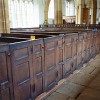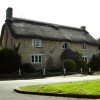At the western extremes of the county near the border with Devon in countryside tumbling with steep hills and deep combes lies Bettiscombe, a tiny hamlet on the north side of the Marshwood Vale. Its Manor House is known as the home of a Screaming Skull that, apparently, screams when it is removed from the house. This artefact has been inspected, tested and reported on by experts who have attested to various theories about its origin, though none of them have provided any authenticity for the legend so we will say no more about it.
The building of the Manor House was completed by Nathaniel Pinney early in the 18th century. His father was John Pinney, who had a farm at Bettiscombe in the time of Charles II and succeeded Thomas Fuller as rector of Broadwindsor; John Pinney died in 1705. It comprises a straight-forward two-storey front with two short side wings at the rear. The entrance is dignified with a hood formed of a Doric entablature and pediment resting on carved and scrolled brackets; the front of the hood is supported by posts that were added later. Standing under the Pilsdon Hill, this unpretentious country house has a view across the Marshwood Vale to the line of hills that run down to Lyme Regis.
About a quarter-of-a-mile from the Manor House near the middle of the parish is the church of St. Stephen. The Dorchester architect John Hicks undertook the rebuilding of this church in 1862 and incorporated three windows partly of the 14th century from the earlier church.
There are memorials to members of the Pinney family who have been associated with Bettiscombe for over three hundred and fifty years. Nathaniel Pinney’s son, Azariah, inherited the house in 1724. Two members of another branch of the Pinney family who supported the Duke of Monmouth in his 1685 attempt to seize the throne were transported to the West Indies after paying a ransom to have their death sentences commuted to penal transportation. John Frederick Pinney, the son of one of these men, returned to join his cousin Azariah Pinney at Bettiscombe; he later became Member of Parliament for Bridport. Azariah Pinney had no children and John Frederick Pinney never married.
A cousin, John Pretor, inherited the estate. He was appointed High Sheriff of the county at the young age of twenty-four. He changed his name to John Pretor Pinney and set about managing the family estates in the West Indies, eventually disposing of the estates. In 1780 he returned to England and lived at Bristol. His home has been restored and decorated to its original state and is now a museum known as The Georgian House at 7, Great George Street, Bristol.
Note: Changes were made to this article on 12th April 2013.



